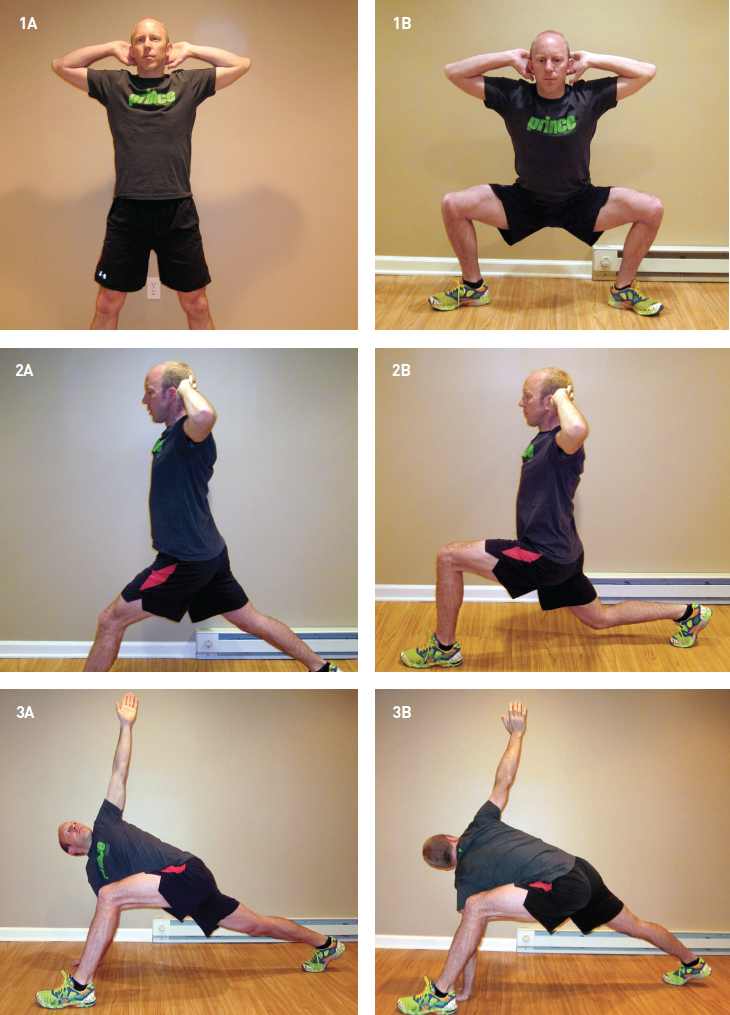By Damon Leedale-Brown, Sports Scientist & Conditioning Specialist
Many players have come to the end of their competitive season in the US which typically begins to wind down from mid-March onwards, with the only major championships of note being the Silver and Bronze Junior Nationals taking place in April.
In the previous article we discussed the challenge of maintaining fitness towards the end of a long hard season, and the tendency to see a higher incidence of injury in the second half of the season due to deteriorations in body health. The off-season presents a great opportunity to initially take some time away from the court, and also focus on key areas of physical and mental regeneration before moving into more demanding phases of off-season training and gradually increasing time back on the court.
There are many factors that determine a player’s ability to move with freedom, control and efficiency on court, and tolerate the movement challenges presented to their body without breaking down. Based on my experience of working with World Class players for over 15 years I firmly believe that one of the most important physical areas for any player is their range of motion (ROM) around key joint areas (i.e. ankle, hips, mid-back, etc.) which is determined by flexibility and mobility.
Flexibility is the range of motion around a joint—largely determined by the condition of the muscle, tendons and ligaments connected through that joint. Mobility refers to how well the joint moves. ROM can be limited by inflexibility of soft tissue structures and by poor joint mobility, and clearly flexibility and mobility are heavily interconnected. Not surprisingly a high percentage of injuries sustained both in training and competition are a result of limitations in ROM which lead to deficiencies in movement and force a player to compensate which is never a good thing!
Let’s consider some of my favorite exercises that help target both flexibility and mobility and can be performed as a mini-circuit design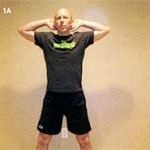 ed to help improve overall ROM. The following exercises are part of a specific sequence performed regularly by current World No. 3 James Willstrop who, for a player of his stature (6′ 5″), moves remarkably well and is rarely away from the court with injury.
ed to help improve overall ROM. The following exercises are part of a specific sequence performed regularly by current World No. 3 James Willstrop who, for a player of his stature (6′ 5″), moves remarkably well and is rarely away from the court with injury.
1. Sumo-Squat (Photos 1A & 1B)
- Stand with feet shoulder width apart and hands to the side of the head.
- Turn feet so toes are pointing outwards at an angle of at least 45 degrees.
- Lower down into squat with a focus of maintaining a strong upright torso position, and sitting down and back into hips
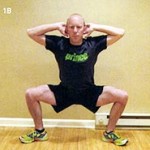 with weight through heels.
with weight through heels. - Collapsing forward with upper body, or lifting the heels off the floor are both signs of compensation for limited ROM. Also be very aware of keeping the knees tracking in line with the 2nd and 3rd toes; it is easy for the knees to collapse inward due to tight adductors/hamstrings and weak outer hip muscles.
- Control speed of movement into the squat so you take approximately 4 seconds to get to the end position.
- End position should be with hips at least down to the height of the knees, thighs parallel to the floor, and heels firmly on the ground.
- Hold end position briefly before moving with control back to start position.
- Perform 2-3 sets of 8-10 reps.
2. Split Squat/Lunge (Photos 2A & 2B)
- With hands held to side of the head get into the start of a split squat position—make sure there is good separation between the feet, and that knees and hips are facing forwards.
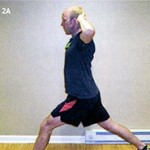
- Lower slowly into split squat with a major focus on the back leg, dropping the back knee slightly back and down towards the floor until the knee almost touches the floor.
- There should be no forward movement in this exercise, and in the end position the knee of the front leg should remain directly above or behind the line of the ankle.
- Forward movement of the torso, and an excessive arch/extension through the lower back area are signs of compensation.
- Take 4 seconds to lower into position and, if done correctly, you should really feel a stretching/lengthening sensation through the front hip and thigh area of the rear leg.
- Hold end position briefly and then move back to start position with control.
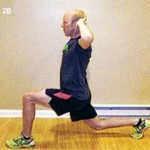
- Perform 2-3 sets of 8 reps each leg leading.
3. Hip Opener and Upper Body Rotation (Photos 3A & 3B)
- Start on the floor in a push-up position.
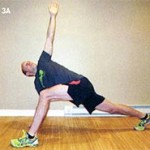
- Step through with left leg aiming to get the left foot alongside or in front of the left hand.
- Lifting the left hand off the floor, turn inwards towards left leg and aim to reach left hand up to the ceiling. This should be performed with a focus on rotation through the mid-back (thoracic spine) area and with little or no movement from the hips.
- A break or collapse in position of the hips is a sign of compensation in this movement.
- Return left hand to floor and then perform rotation in opposite direction with right arm—for most players this will be the more challenging direction of movement.
- Return right hand back to floor and then step left leg back to start position.
- Repeat sequence with right leg stepping through.
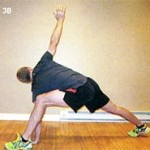
- Perform 2-3 sets of 16 reps alternating between left and right leg step through.
4. Lateral Squat (Photo 4)
- Start with feet approx. 3.5 – 4 feet apart (wider than shoulder width).
- With hands held out in front of body begin to shift slowly to the left side taking approx. 4 seconds to reach your end position.
- Aim should be to sit as low as you can into the hip of the side you are shifting over to.
- The feet must remain pointing straight forwards at all times and with both feet firmly in contact with the floor.
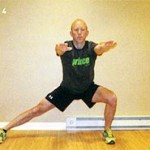
- External (outward) rotation of the feet, or the foot of the straight leg being rolled inward are both signs of compensation.
- Hold end position briefly and then move with control back to start position before commencing movement across to right side.
- Perform 2-3 sets of 8-10 reps each side.
The key to these exercises is performing them correctly with a good understanding of how you are trying to ask the body to move. It is very likely that you will find difficulties in reaching the true end position on some of the exercises without compensations which should be avoided at all costs. Your approach should always be one based on an awareness of your limitations in ROM, and a desire to improve over time with a consistent approach to performing this sequence of exercises ideally 3-4 times per week.
Stick to your task and you could be moving like James Willstrop in a few weeks time!


